Final report for ENE14-133
Project Information
Greenhouse and high tunnel vegetable production is increasing in New York State and the Northeast however many Extension Educators are lacking the specific experience, information and training to provide assistance to this growing industry. We believed that providing training for Extension educators in Integrated Pest Management (IPM) tailored for the production system and specific pests found in vegetable production under protected environments (high tunnels and greenhouses) will lead to an increase in the adoption of IPM by growers.
A total of 50 Extension educators and 73 growers received training and information on IPM for high tunnels/greenhouses through:
- Project-developed “How to develop an IPM Plan” document
- A list-serve with an associated Box file of resources – 65 Extension Educators/faculty are members
- Webinars – 8 webinars presented live on-line and archived covered the basics of high tunnel/greenhouse vegetable production and integrated pest management (IPM), 22 educators participated in the live webinars
- In-person training – a 2 day program held in Geneva NY covered the development of an IPM plan and was attended by 10 Extension educators and 9 growers
The content areas covered in the webinar training were: Fertility and water management in high tunnels and greenhouses, Production factors that relate to IPM, Disease, insect, and weed management in high tunnels and greenhouses, and How to write an IPM Plan. The In-person training reviewed some of the same information but emphasized the development of an IPM plan through discussion with growers and on-farm tours.
Eight of the trained educators organized five grower training programs in 2017 and 2018. 62 growers, 9 ag service and 7 others who included high school agriculture students participated in these events held throughout NYS (Chenango, Oneida, Putnam, Suffolk and Tioga Counties - one was planned for Wyoming County but canceled due to lack of registrants). 28 growers responded to evaluation surveys at 3 of the trainings; 19 reporting learning something new about the IPM topics taught, and 20 reported their intent to make changes based on what they learned. Content of the educational programs varied based on the hosting educator but all included the how-tos for creating an IPM plan. Several had an emphasis on utilizing biological control, and season extension methods.
Forty six service providers received an end-of-project verification survey; of the 22 who responded 8 had participated in at least one aspect of the program. The survey did not ask numbers of growers in some questions but based on information discussed in the report, it is likely quite low). One respondent shared information from the list-serve, webinars, and training with at least one grower, and also held a grower workshop and visited a farm. Three others participated in the list-serve and webinar and shared information from each with at least one grower. One more participated only in the list-serve and shared information with at least one grower. An additional respondent did not participate in any of the program activities, but did hold a grower workshop and sent information to 5 growers.
Growers also had access to training and information on IPM for high tunnels and greenhouses through the list-serve and archived webinars – accessed over 200 times.
The intent of the project was that Extension educators who had been trained would extend the information to growers through working with a grower one-on-one to develop an IPM plan and then conduct a demonstration or informational meeting of other growers. While a survey at the end of the project showed that 5 Educators used what they learned to educate at least 5 growers, these numbers were lower than targeted and no educators reported on developing IPM plans with growers. It proved to be more challenging than expected to encourage the Educators to follow through on this activity and therefore we were unable to verify grower action outcomes resulting from the efforts of the Educators trained through this project.
The objective of this project was to provide training for Extension educators in IPM tailored for the production system and specific pests in vegetable production under protected environments (greenhouses and high tunnels). The intent was to lead to an increase in the adoption of IPM by growers, with its potential to reduce pesticide use and improve product quality.
Overall performance targets: 20 Extension educators will co-train with growers in greenhouse vegetable IPM to provide grower support; 10 will conduct educational programming for 150 growers; 8 will create an IPM plan with a grower then demonstrate it for 160 growers. Thirty growers will document an increase in IPM in their vegetable greenhouses.
Greenhouse and high tunnel vegetable production is increasing in New York State and the Northeast. Many of the growers who are producing vegetables in an enclosed environment are new to the growing system or the crops and the pest complex and management solutions can be very different from field operations. Integrating cultural and biological management methods into the greenhouse production system is essential but can be difficult. Many Extension educators around New York State are lacking the specific experience, information and training to provide assistance to this growing industry. An email survey was conducted of extension educators in NY’s 62 counties in September 2013. Twenty-one Extension educators expressed an interest in helping the greenhouse/high tunnel vegetable producers with their pest management.
Providing training for Extension educators in Integrated Pest Management (IPM) tailored for the production system and specific pests found in vegetable production under protected environments will lead to an increase in the adoption of IPM by growers. Educators indicated that they would want to participate in hands-on training (15), receive continuing subject matter support through web-based conferences (15), conduct grower programming (11) and work one-on-one with growers to create an IPM plan (8). For this project, on-line and archived webinars on the basics of high-tunnel/greenhouse vegetable production were followed by in-person training and supported by a list-serve for questions, with the intent that information would be transferred to growers in the counties.
Cooperators
- (Educator)
- (Educator)
- (Educator)
- (Educator)
Educational approach
As this project encouraged education at several levels, we tried to include a variety of educational approaches within the project. Training for Extension educators included archived webinars to allow visual, and repeatable, training. This was coupled with resources that relate to the webinar topics as well as other topics requested by the educators that can be accessed as needed. A face-to-face discussion based training program was included to help develop support among educators and other resource people. Training for growers by educators was by the more traditional seminar talk and question approach but was paired with a greenhouse tour to encourage more discussion and experiential learning.
Milestones
1) 80 Cornell Cooperative Educators will learn about the Greenhouse Vegetable IPM training program.
80
85
June 30, 2016
Completed
November 30, 2016
We created an on-line survey in Qualtrics to be distributed to CCE educators who cover a broad range of expertise areas. We included the 3 regional Extension teams that cover multiple counties – Eastern NY Commercial Horticulture Program, Capital Area Ag and Hort Team, and the Cornell Vegetable Program – which all include some vegetable specialists. We also included lists of county-based educators who work with commercial and consumer horticulture. In total, the survey was sent to 85 CCE educators (there may have been a few duplications).
With the survey, we sent a description of the project, the planned webinars, and the hands-on workshop.
We started with the educators in NYS as we have better connections with them and thought they might be more likely to return the surveys. In the future, we will contact educators in neighboring states in the region to determine how we might provide the same information to them.
2) 30 Extension educators will return survey on current level of knowledge, desired topics, and regional programming needs.
30
24
July 31, 2016
Completed
December 30, 2016
We received 24 responses, including educators from 16 counties and 2 regional teams. They reported a variety of areas of expertise or work – 5 in Consumer Hort, 3 in vegetable crops, 3 in Natural Resources, 2 in ornamentals, 2 in general agriculture or horticulture, and 3 in various areas. Seventy eight percent work with GH/HT growers of vegetables (7) or ornamentals (2), or both (9). An additional 6 said they don’t currently work with these growers but are interested in learning more.
The primary topics to be covered in the webinars and as part of creating an IPM plan are: vegetable crops produced in GH/HT, production factors for this type of production, and insect, disease and weed management in GH/HT vegetable production. While 46% of respondents said their knowledge of the crops was medium, the majority rated themselves as having low knowledge of the topics covered by the project:
Production factors for GH/HT vegetable production 46%
Insect management in GH/HT vegetable production 54%
Disease management in GH/HT vegetable production 63%
Weed management in GH/HT vegetable production 42%
At least 70% indicated each of these topics to be of potential interest to them:
Basics of light, water, fertility, and media in a GH/HT 87%
Vegetable crop production in GH/HT 75%
Insect management in GH/HT vegetable production 79%
Disease management in GH/HT vegetable production 75%
Weed management in GH/HT vegetable production 71%
Case studies from successful growers 75%
Other things suggested (some of which don’t fit into this project but that we can find resources for) were specialty crops, low tunnels, and business plans.
We asked what other information they felt they would need to be successful in assisting growers with pest management issues in GH/HT vegetable production. Their answers included: cover crops, pesticides labeled for use on edible crops in GH/HT and efficacy data, a definition of GH/HT in respect to pesticide use, fertigation basics, water management, economics – when is it worth it, other crops – small fruits, figs, ginger, and understanding differences in production under the different environments of field and GH/HT.
We asked for estimates of the number of GH/HT vegetable growers in their county or region, in order to determine if it would be likely they would have a grower to work with. Realizing that counties and regions vary dramatically in size and that those not already working in this area might not know the answer, the most common estimate was 2-10. The primary crops grown were (in order of frequency of mention and with the same caveats) tomatoes, cucumbers, greens, peppers, berries, brassicas, herbs, and vegetable transplants.
Ninety-two percent were definitely or possibly interested in participating in webinars. All were definitely or possibly interested in the hands-on training. Seventy-eight percent might have a grower to participate with them.
3) 20 Extension Educators learn about listserve and web site for resources.
20
19
36
August 31, 2016
Completed
February 28, 2017
We created a list-serve (Greenhousevegipm) through the Cornell University list-serve system for Extension Educators interested in participating in the greenhouse/high tunnel vegetable IPM project. At first, it was only open to those in the project to allow freedom for discussion that might not occur if it was a more public list. However, the participants decided that making it a more public list was acceptable so participating growers and others interested in the topic have been added over time. There are currently 36 educators and Cornell faculty, and 19 growers on the list. As we hold trainings, others are invited to participate so the numbers will increase.
A Box folder, also through Cornell University, was created as a site to house resources related to IPM in vegetable greenhouse/high tunnel production. Currently, there are 70 Extension Educators and faculty on the editor list. While those outside the university system can be included on the list, we believe there are better options for housing this information, which we will look into. Currently there are 97 files in the Box, mostly relating to the webinar topics. Over time, resources presented at the grower meetings will also be added.
4) 20 Extension Educators attend series of webinars to cover the topics listed in the grant.
20
22
February 28, 2017
Completed
March 23, 2017
Based on the topics of interest to educators that were identified in the survey, we created a webinar series held every Thursday noon in February and March 2017 for approximately one hour. We identified speakers from the project team and Cornell faculty and requested resources from them for the Box file to support their topics.
Feb 2: Introduction to the project – Betsy Lamb
Feb 9 Soilless media fertility/water management – Neil Mattson
Feb 16: In-ground fertility/water management – Judson Reid
Feb 23: Production factors for greenhouses and high tunnels that relate to IPM – Amy Ivy
Mar 2: Disease management in greenhouses and high tunnels - Brian Eshenaur/Amy Ivy
Mar 9: Insect management in greenhouses and high tunnels - John Sanderson
Mar 16: Weed management in greenhouses and high tunnels – Betsy Lamb
Mar 23: How to write/use an IPM plan – Betsy Lamb
Webinars were advertised through the project list-serve and also through another list-serve of Extension educators. They were accidentally advertised to the public, which was picked up by an international greenhouse list-serve, so we included approximately 40 others on a list to be alerted when the webinars were posted on the website.
The webinars were run using the Zoom system, which is supported by Cornell. It is a relatively easy system to use and participants did not seem to have problems connecting. It has a chat function for questions and we always had someone other than the speaker coordinate asking the questions during or after the webinar. At the end, we had the option of opening up the microphones for other comments and questions.
Of the 22 educators participating in the webinars, 12 attended at least half and the average attendance was 3.5. Because of educators’ busy schedules and varying experience with the topics, we didn’t expect that everyone would attend all of the programs. Therefore, we recorded all the sessions and posted them on the NYS Integrated Pest Management website with public access. They can be found at: https://www.youtube.com/playlist?list=PLoNb8lODb49u_mSvLTTZUGPfn-WTvERV3 This allows viewers to watch them again, but also allows us to use them more broadly. After each webinar was posted, it was advertised through a wider greenhouse IPM industry list-serve so the number of growers who have viewed them may be greater than we can measure. In the future, it would be interesting to have a pop-up survey question to know who is watching and their reasons for doing so.
Number of views as of 12/28/17
Introduction to the project - 200
Soilless media fertility/water management - 97
In-ground fertility/water management - 65
Production factors for greenhouses and high tunnels that relate to IPM - 114
Disease management in greenhouses and high tunnels - 69
Insect management in greenhouses and high tunnels - 131
Weed management in greenhouses and high tunnels - 28
How to write/use an IPM plan - 44
We surveyed the 20 attendees at the April 2017 workshop described below (20 responses) on their opinions on the webinars. This isn’t the entire group of educators who viewed the webinars and it could be considered a skewed population as they were interested enough (and had the time) to attend the workshop, but we think the answers are still relevant.
All respondents said the webinars were useful, and had information that was new to them. Most commented that they liked that the webinars were archived so they could review them later. Twenty-five percent participated in the webinars live, 56% on YouTube and 19% both. The fertility topics were considered most helpful, and they liked topics that included on-farm examples. All would like to continue the series, and 78% said they would use the archived versions as a resource for growers.
5) 15 Extension educators participate on list serve to identify additional resources needed.
15
19
36
February 28, 2017
Completed
June 17, 2019
Since the list-serve was created, there have been at least 46 messages sent out to participants. This includes announcements of meetings that might be of interest to the membership, new resources, and answers to questions posed by the group. We need to encourage use of the list-serve multi-directionally so questions, answers, and resources are posted by a wider group. We will continue working on this in 2018.
As of June 2019, there are 62 members of the list serve - 33 are Extension-educators and Cornell faculty. There were 44 messages sent out in 2018 and, to date, in 2019, 21 messages, primarily pest alerts and relevant webinars and meetings. The most common use is to broadcast information. Occasionally there are questions sent in or comments on posts. Other Extension educators have requested that messages be sent out on the list to advertise programming.
6) 15 Educators and growers attend 1-2-day hands-on workshop to create IPM plans and plan for on-farm demonstrations or tours, complete evaluation of workshop and additional educational needs.
15
9
10
June 30, 2017
Completed
May 01, 2017
The workshop was held April 26-27, 2017 with the primary intent being to develop connections between Extension educators, growers, team leaders, and other resource people. We met in Geneva at the NYS Agricultural Experiment Station, which allowed us to interact with some of the local faculty working on high tunnel crops and to visit their high tunnels. In addition to an overview of the project and IPM in high tunnel vegetables, there was an open-ended group discussion on the ‘Writing an IPM plan’ document. We had asked the participants to watch the webinars if they hadn’t attended ‘live’ so that everyone would have a similar basis of knowledge. The group also toured greenhouses in Penn Yan (Hoover) and Phelps (Fellenz) to see how IPM works in a commercial system.
Not including the project team and the Cornell faculty, 10 Extension educators, 1 Master Gardener and 9 growers attended the workshop.
From the survey, we learned that attendees favorite parts were the ability to interact with each other, having growers attend the workshop, touring farms with the owners available for questions, discussion of the IPM planning procedure, and the accessibility of Cornell staff. Some of the ‘Aha!’ moments were: the differences between high tunnel and greenhouses and other growing systems, how much work it is to be a farmer, greenhouse/high tunnel construction issues, and water pH and alkalinity. Everyone liked the farm tours because of the benefit of seeing what we were discussing, having the grower viewpoint, the diversity of systems we visited, and the practical application of information. Everyone also appreciated the discussion of the IPM planning document because it allowed for a variety of experience and viewpoints to be applied to the issue, there was an exchange of ideas and lots of input, and because they appreciate peer learning. The educators all liked having the growers participate in the workshop because of their practical knowledge and insights, because of suggestions of topics that would be useful to them, and because it allowed educators and growers to get on the same page. The growers appreciated the ability to attend because of the awesome support, and the wealth of experience and knowledge.
In general, attendees like the session on creating an IPM plan. They loved the format of a written plan and the fact that all the facets were in one piece, and that they could take it home to think about it. They thought having growers and educators brainstorming together made a difference, especially because it was a lot of information and might need specific situations to be able to work through it all. Everyone felt more confident in handing high tunnel pest management questions because they now have resources.
We asked what we could offer to help them in holding regional meetings. They would like help with identifying speakers and collaboration with local agencies, covering some of the costs, helping to coordinate with other regional Extension offices, and our presence as moral support.
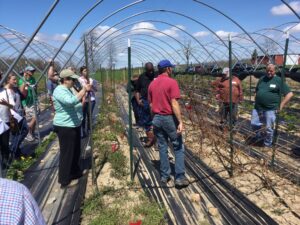
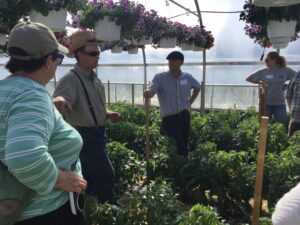
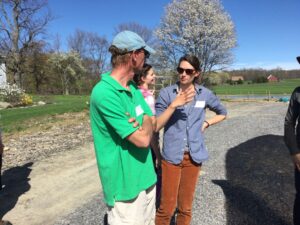
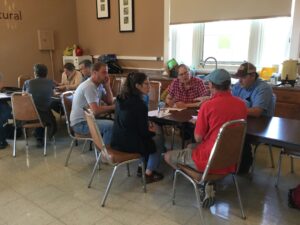
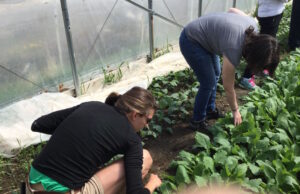
7) 10 Educators plan and conduct formal or informal grower training program as appropriate for clientele group, evaluate grower response.
10
62
8
June 30, 2018
Completed
July 31, 2018
Educators organized five grower training programs in 2017 and 2018. Two others were scheduled but canceled because of the low numbers signing up. We are working on some additional measures to reduce this problem as we continue to work with the educators on planning. Many of the educators that went through the training don’t have specific responsibilities for training growers – although they are interested in knowing more about it because the need is there and the county has no specific agriculture educator. So they may not know the growers, or know the best time to hold a meeting. For example, in Wyoming County, many of the high tunnel growers also hay and the date chosen happened to have good weather for haying.
In Oneida County, the program was held August 7, 2017 with 25 attending. The group was mostly growers, but a group of agriculture students and their advisor from the local high school also attended. The agenda is appended below. Steve Adamkowksi led a tour of his vegetable and ornamental high tunnel at Freedom Farm Market. In addition to Holly Wise and Terri Harrison, who are educators in the county, Lilly Calderwood from the Capital District Extension program also attended.
Of the 12 responses on the evaluation, 8 already owned some type of protected growing structure. Tomatoes and cucumbers were the most commonly produced vegetable but growers also produced lettuce, herbs, Asian greens and peppers. One grower already had an IPM plan, 6 use IPM but didn’t have a specific plan, 1 used IPM practices but didn’t know it was IPM and 2 said they don’t use IPM practices. Six indicated they had learned something new about IPM. Seven indicated that there are changes they will make in their production based on what they learned. Most common responses were improved organization and record keeping, using the IPM planning document to create a formal IPM plan, increasing the use of soil and water testing, and increasing scouting and identification of plant diseases. Ten would be interested in participating in a webinar series.
In Tioga County, the program was held October 2, 2017 with 12 attending. Barb Neal, Elizabeth Lamb, Judson Reid and Brian Eshenaur presented. Most attendees were growers but the local NRCS representative also attended. We toured Our Green Acres with Keith Slocum, one of the growers who attended the workshop.
Of the 8 evaluation respondents, 6 have some sort of protected production. Tomatoes were the most commonly produced crops, with herbs, peppers and ornamentals following. One grower already had an IPM plan, 2 use it although without a specific plan, 1 used IPM without knowing what it was, and 1 did not use IPM methods. Five noted knowledge gained, including how to make an IPM plan, biocontrol options, disease resistant varieties and managing plant environment for disease management. Six growers plan on making changes based on what they learned, including better scouting, better record keeping, improving ventilation, and increasing use of beneficials for insect control. All would like to participate in a webinar series.
In Putnam County, the program was held October 31, 2017. County educator Jennifer Lerner did a survey of attendees before they arrived. Seven of the 13 attendees already have high tunnels and 4 didn’t know what IPM is. Growers produce, or wish to produce, tomatoes, cucumbers, a variety of greens and ornamentals and mentioned a variety of production issues. The program was held at Yarrow Hollow Farm, sponsored by Sarah Lucas, who was a workshop attendee. Both the Putnam County Soil and Water Conservation District and the Natural Resource Conservation Service were involved in the program.
Of the 8 evaluation respondents, 1 grower already had an IPM plan, 3 are very likely to write one, and 4 might give it a try. The 2 grower who didn’t already have high tunnels are now more likely to get one. All 8 learned something that can help them extend their harvest season, diversify their crops and better plan for pests. Several mentioned the importance of environmental control. Seven are very likely to use concepts they learned and 1 might give it a try.
Two more educational programs were held in 2018. The first, in Chenango County on July 10 was requested by a greenhouse grower after attending the program in Oneida County. In addition to the IPM Plan presentation, there was an emphasis on applying beneficial insects. Debbie Palumbo-Sanders from Bioworks presented and Carol Glenister from IPM Labs participated in the greenhouse tour portion at Pires Flower Basket. Bioline provided a sample pack of beneficial insects for growers to examine and to demonstrate appropriate methods of application. There were 8 attendees
The second program was held in Riverhead NY on September 20 with 22 attendees. I collaborated with Nora Catlin and Sandy Menasha from Cornell Cooperative Extension of Suffolk County to invite growers, find a greenhouse to tour and organize the meeting. In addition to the IPM Plan presentation Teresa Rusinek (Eastern NY Commercial Horticulture Program) spoke on the major pests of cool season vegetable high tunnel production, and Greg Bryant from Bioline spoke on biological control. We visited Sang Lee farms to demonstrate application of biocontrols. Sandy Menasha reported "really great feedback from the workshop” and is planning something similar for January 2020.
We were not as successful at encouraging Extension Educators to schedule grower programming on IPM for high tunnels/greenhouses as we had hoped. Even the offer of funds to cover costs and providing speakers for the programs was not sufficient enticement. Indications are that time is more valuable than funding. Even many of the educators who had gone through the training did not hold grower events. It may also be that, since they did not already have a list of growers to invite, having to create a clientele group was too much of a barrier when they have existing clientele groups and not enough time to support them.
Across the 5 programs, 62 growers (Oneida-18, Tioga-11, Putnam-11, Chenango-3, Suffolk-19), 9 ag service providers (Oneida-1, Tioga-1, Putnam-2, Chenango-3, Suffolk-2), and 7 others (Oneida-6 including students, Suffolk-1) participated.

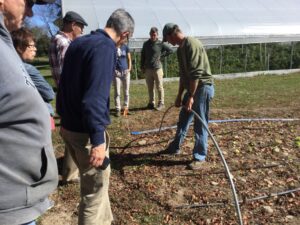
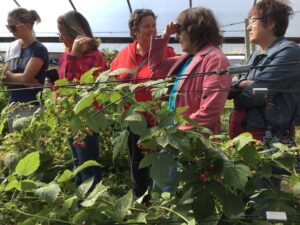
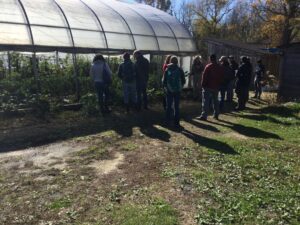
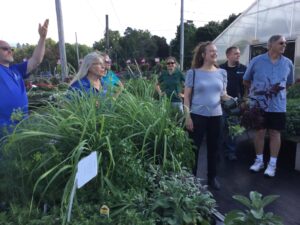

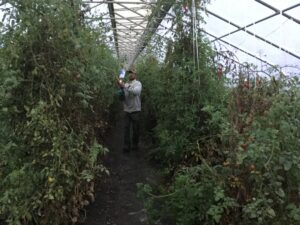
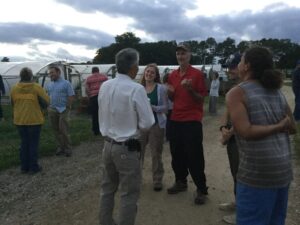
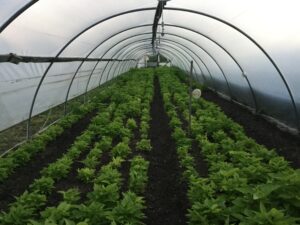
8) 10 Complete verification survey to report on Extension Educator response to training, interaction with growers, and grower impacts.
10
22
August 31, 2018
Completed
June 01, 2019
We ran a survey in April/May 2019 to determine how Extension Educators have been using what they learned from the project. We sent the survey to the apparently relevant Educators in all counties (46 – which does not include the 10 counties with no relevant horticulture Educator).
Twenty-two educators responded to the anonymous on-line survey. Of those, 14 work with commercial horticulture audiences. Eight respondents had participated in at least one aspect of the program - 7 in the listserve, 6 in the webinars, 1 in the training program, and one held a grower workshop although didn't participate in the other activities. It is a bit interesting that so few of those who actively participated responded to the survey.
Fewer shared information they learned with growers, which is perhaps understandable as many who participated in the various aspects of the program did not previously work with growers. I have found that growers will give up on an Extension office if they don't find help there, so that may limit the potential for interactions. One respondent participated in all 3 activities and shared information with at least one grower (the survey did ask for grower numbers by type of information provided but there were very few responses) from each, and also held a program with some follow up with at least one grower. Three respondents participated in both the list-serve and the webinar series, and shared information from both with at least one grower. An additional respondent participated in the list-serve only and shared information with at least one grower. The person who only held the grower workshop also sent information to 5 growers. Most of the information relayed to growers related to pest management, which suggests it was the information provided in the list-serve, webinars, or training.
The ranked preference for how to receive information was (from highest to lowest):
- Training in person
- Assistance with grower meeting in county
- Live webinars
- On-line archived webinars
- List-serve
This is based on very few responses but is similar to what we have seen in other situations. However, it does not correspond all that well to participation numbers from this project.
The initial steps in developing a cadre of county-based Extension educators who work directly with high tunnel/greenhouse growers to improve their use of IPM have been taken but more work needs to be done to make this a long-lasting group.
There are several indirect benefits of this project, which hopefully will enable us to continue to reach both Extension Educators and growers with additional IPM information.
- The IPM plan document is adaptable to a variety of situations and will continue to be used with growers.
- We have gained additional expertise with the webinar function of Zoom and will continue to create and archive webinars with information relevant to high tunnel/greenhouse producers. This will require a planned production cycle so people come to expert new information.
- The list-serve and Box file are continuing resources. They require planned, consistent and continued input, as well as advertising to growers, to be valuable. The Box file needs to be transferred to a platform that is more publicly available
- We have developed relationships with a broader base of Extension Educators. This allows us to both answer any questions that come up and to get input on what types of information are needed . Also, the connection allows us to include local Educators in our programming so that grower/Educator networking can develop.
9) 8 Create IPM plan with grower and conduct on-farm demonstration, evaluate grower response
10) 8 Complete verification survey to report on grower response to demonstration, interaction with growers, and grower impacts.
8
August 31, 2017
Completed
June 24, 2019
Some of the trained educators went on to provide education to farmers (see milestone 8), however, the project was unable to obtain data from educators to verify how growers implemented IPM information learned. This was a disappointment because our initial survey led us to believe there was a sufficient group of educators who wanted to work with high tunnel/greenhouse growers on pest management.
We believe there may be multiple reasons for fewer educators that expected teaching growers and for educators’ inability to report grower actions. Reasons include educators being extremely busy, high tunnel/greenhouse growers being a new clientele for some educators, and some high tunnel/greenhouse growers may not be accessing Extension for their information. Hence, educators don’t know growers and vice versa and neither the push nor pull for creating programming on high tunnel/greenhouse IPM was strong.
We will continue to look for opportunities to work with high tunnel/greenhouse growers on IPM and will involve local Educators in our programs to continue encouraging the development of a network for information exchange. The fact that we have had a few requests for additional programs is a sign that success is possible.
Milestone activities and participation summary
Participants in the project’s educational activities:
Learning Outcomes
Written evaluations were completed by attendees of the workshop and for all three of the county-based grower programs.
Key areas are what integrated pest management is and how to create an IPM plan, environment as a component of pest management, biological control, and resistant varieties.
Performance Target Outcomes
Performance Target Outcomes - Service Providers
Target #1
10
10 of 20 Extension educators who co-train with growers in greenhouse vegetable IPM to provide grower support will conduct educational programming for 150 growers;
150
13
73
Target #2
8
8 of the service providers will create an IPM plan with a grower then demonstrate it for 160 growers.
160
0.0
0.0
- 6 Consultations
- 5 Workshops/field days
The verified outcome data comes from the data provided by educators who organized the 5 programs for farmers (62 growers), 9 farmers who co-trained, and the estimated at least 10 growers contacted by 6 participants from the end-of-project survey. One respondent shared information from the list-serve, webinars, and training with at least one grower, and also held a grower workshop and visited a farm. Three others participated in the list-serve and webinar and shared information from each with at least one grower. One more participated only in the list-serve and shared information with at least one grower. An additional respondent did not participate in any of the program activities, but did hold a grower workshop and sent information to 5 growers.
While there may be additional activities that were not reported on the survey because of the response rate and who responded, the numbers of verified activities and participants were lower in than our performance targets. The primary barrier was in our providing the right encouragement for Educators to work directly with growers, even to the extent of assisting with a grower education event. Our initial survey data indicated a higher interest in the project activities that we actually experienced, especially in working one-on-one with growers in developing an IPM plan, which led to outcomes that were less than our performance targets.
Performance Target Outcomes - Farmers
Target #1
30
Thirty growers will document an increase in IPM in their vegetable greenhouses.
0.0
The only way, for this project, to assess actual implementation of knowledge gained by growers was through Educator interaction with growers directly. Because the educators participating in the project did not report identifying and working with growers one-on-one, we were not able to verify the intended outcome of farmers adopting IPM in their vegetable greenhouses.